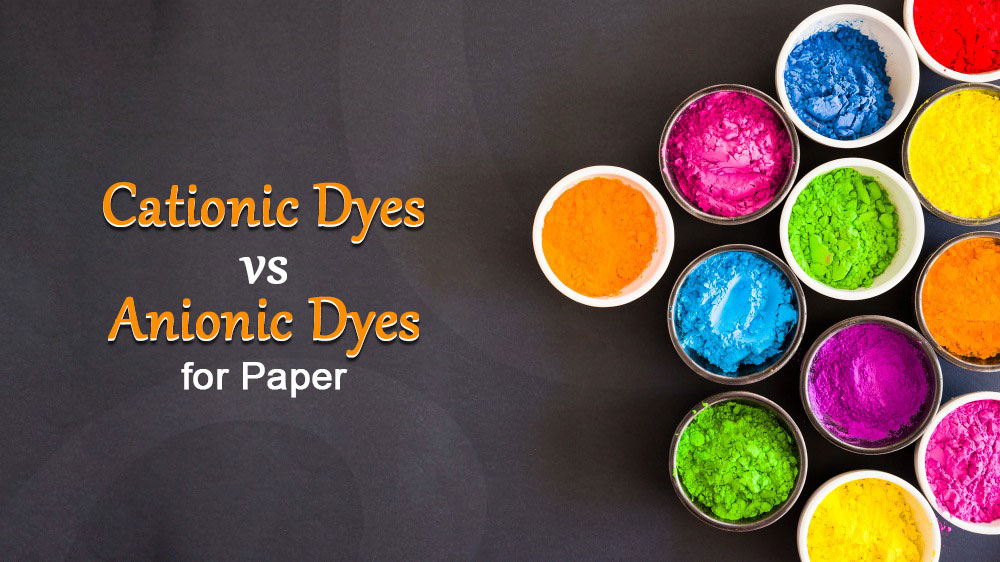The world of paper manufacturing is a fascinating realm where chemistry and artistry converge. At the heart of this intricate process lies the crucial choice between cationic dyes and anionic dyes. Basic dyes for paper play a pivotal role in determining the final aesthetic appeal and functionality of paper products. We are the Basic Dyes Manufacturers in India, understanding the differences between cationic and anionic dyes is essential for optimizing the paper production process.
Importance of Cationic and Anionic Dyes
Cationic dyes and anionic dyes represent two distinct classes of colorants used in the paper industry. The importance of these dyes lies in their ability to impart vibrant and long-lasting colors to paper fibers. Cationic dyes are positively charged molecules, which makes them adept at binding to negatively charged cellulose fibers. On the other hand, anionic dyes, with their negative charge, exhibit a natural affinity for positively charged fibers. This fundamental difference in charge interactions leads to diverse applications and advantages in the paper manufacturing process.
Cationic Dyes:
- Wide Range of Vibrant Hues: Cationic dyes cover a broad spectrum of vivid colors.
- Paper Dyeing Applications: These dyes are extensively used in dyeing paper for diverse purposes.
- Brilliant Coloration: Basic dyes, typically falling under the cationic category, are known for their outstanding color brilliance.
- Excellent Light Fastness: Cationic dyes exhibit high resistance to fading, ensuring long-lasting color on paper.
- Popular for Artistic and Decorative Applications: Due to their ability to produce deep and vivid shades, cationic dyes are favored for artistic and decorative uses.
Anionic Dyes:
- Water-Solubility: Anionic dyes are valued for their capacity to dissolve in water.
- High Solubility: Ideal for applications requiring a high level of solubility, such as inkjet printing and specialty papers.
- Inkjet Printing: Anionic dyes are commonly employed in inkjet printing, contributing to excellent color reproduction.
- Specialty Papers: These dyes are suitable for specialty papers, enhancing print quality and overall performance.
- Diverse Applications: Anionic dyes offer versatility in applications where water solubility is a crucial factor.
Uses of Cationic and Anionic Dyes in Paper Manufacturing
The uses of cationic and anionic dyes in paper manufacturing are diverse and extend across a spectrum of applications. Cationic dyes are favored for their ability to produce intense colors on paper, making them well-suited for art papers, packaging materials, and specialty products where vibrant visuals are paramount. Their compatibility with cellulose fibers ensures a strong bond, resulting in color stability over time.
Anionic dyes, with their water-soluble nature, are commonly employed in inkjet printing. These dyes are crucial for achieving sharp and high-resolution prints, making them essential for the production of quality photographs, illustrations, and graphics on coated and specialty papers.
In conclusion, the selection between cationic and anionic dyes in paper production constitutes a pivotal choice with profound implications for the ultimate attributes of the paper product. A comprehensive comprehension of the unique characteristics and uses of these dyes empowers manufacturers to customize their procedures to fulfill particular needs. Whether cationic or anionic, basic dyes for paper play a vital role in enriching the varied realm of paper products, guaranteeing that each sheet narrates a distinctive and vibrant tale. In the dynamic landscape of the paper industry, the enduring significance of basic dyes, owing to their capacity to elevate both aesthetics and functionality, remains irreplaceable. We are the Paper dyes manufacturers in India.
